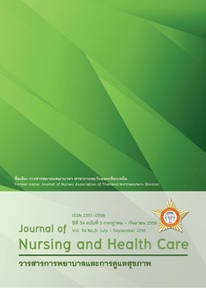ความแตกฉานด้านสุขภาพและผลลัพธ์ทางคลินิกของผู้ที่เป็นความดันโลหิตสูง ไขมันในเลือดผิดปกติ และเบาหวานชนิดที่ 2 Health Literacy and Clinical Outcomes in People with Hypertension, Dyslipidemia and Type 2 Diabetes Mellitus
คำสำคัญ:
ความแตกฉานดา้ นสุขภาพ ปจั จัยสว่ นบุคคล ผลลัพธท์ างคลินิก ผูที้่เปน็ ความดันโลหิตสูงไขมันในเลือดผิดปกติ เบาหวานชนิดที่ 2 health literacy, personal factors, clinical health outcomes, patients living with hypertension, dyslipidemia, type 2 diabetes mellituบทคัดย่อ
บทคัดย่อ
การศึกษาเชิงสำรวจครั้งนี้มีวัตถุประสงค์เพื่อศึกษาความแตกฉานด้านสุขภาพ และความสัมพันธ์ระหว่างปัจจัยส่วน
บุคคลและความแตกฉานดา้ นสุขภาพกับผลลัพธท์ างคลินิกของผูเ้ ปน็ ความดันโลหิตสูง ไขมันในเลือดผิดปกติ และเบาหวานชนิดที่ 2 กลุ่มตัวอย่างคือผู้ที่ได้รับการวินิจฉัยความดันโลหิตสูง ไขมันในเลือดผิดปกติ และเบาหวานชนิดที่ 2 จำนวน 400 คนที่มารับบริการในหน่วยผู้ป่วยนอกโรงพยาบาลระดับตติยภูมิ เลือกตัวอย่างโดยการสุ่มแบบเป็นระบบ เก็บข้อมูลโดยใช้แบบสอบถามและการประเมินภาวะสุขภาพผลการวิจัยพบว่า ตัวอย่างส่วนใหญ่มีความแตกฉานด้านสุขภาพทั้งในภาพรวม และองค์ประกอบขั้นพื้นฐาน ขั้นปฏิสัมพันธ ์ และขั้นวิจารณญาณอยูใ่ นระดับปานกลาง ผลการวิเคราะหค์ วามสัมพันธพ์ บวา่ ปจั จัยสว่ นบุคคลที่มีความสัมพันธ์กับความแตกฉานด้านสุขภาพทั้งโดยรวมและรายองค์ประกอบอย่างมีนัยสำคัญทางสถิติ คือ อายุ ระดับการศึกษา อาชีพรายได้ และความแตกฉานด้านสุขภาพทั้งโดยรวมและรายองค์ประกอบที่มีความสัมพันธ์กับผลลัพธ์ทางคลินิกอย่างมีนัยสำคัญทางสถิติ คือ ค่านํ้าตาลในเลือด ค่าคอเลสเตอรอลรวมในเลือด ค่าแอลดีแอลคอเลสเตอรอล และค่าเอชดีแอลคอเลสเตอรอล ผลการศึกษาครั้งนี้มีต่อพยาบาล และทีมสุขภาพในการให้ข้อมูลเกี่ยวกับสุขภาพควรตระหนักในเรื่องความมีอายุน้อย ระดับการศึกษาน้อย ไม่ได้ประกอบอาชีพ ไม่มีรายได้
หรือรายได้น้อย และไม่มีประวัติโรคประจำตัวในครอบครัว เพื่อส่งเสริมความแตกฉานด้านสุขภาพโดยเฉพาะขั้นจารณญาณและการมีพฤติกรรมสุขภาพที่เหมาะสม นำไปสู่ผลลัพธ์ทางคลินิกที่ดี
Abstract
Objective: To describe the relationship between personal factors and health literacy with the clinical health outcomes of persons with hypertension, dyslipidemia and type 2 diabetes mellitus (T2DM). Material and method:Through systematic random sampling, a sample of 400, who met the inclusion criteria, were recruited in an Out Patient’s Department (OPD) of a university hospital in Bangkok. Data were collected using questionnaires and health assessments. Result: The findings revealed that participants have moderate health literacy overall and on functional,interactive, and critical subscales. The results showed a significant correlation between personal factors and health literacy levels; age, education, employment, income, In addition, there was a significant correlation between health
literacy levels and clinical health outcomes; blood sugar levels, cholesterol levels, low density lipoprotein (LDL) cholesterol and high density lipoprotein (HDL) cholesterol.
This study suggested that nurses and healthcare team should provide health information, particularly to persons with limited health literacy including a young age, low education, unemployment, low income and no family history of chronic illnesses. Furthermore, their knowledge and understanding of appropriate healthcare practices should be promoted to enhance their level of overall health literacy and critical health literacy so that they will be able to analyze information leading to correct and appropriate health behavior, thus more desirable clinical outcomes.



